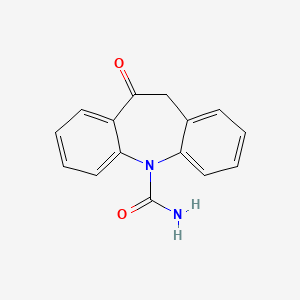
Oxcarbazepine
Cat. No. B1677851
M. Wt: 252.27 g/mol
InChI Key: CTRLABGOLIVAIY-UHFFFAOYSA-N
Attention: For research use only. Not for human or veterinary use.
Patent
US06670472B2
Procedure details


A mixture of 100 gms of 10-methoxyiminostilbene in 1000 mL of toluene containing 351 gms of para-chlorobenzoic acid and 370 gms of sodium cyanate were heated to reflux and refluxed for 12 hours. The reaction mixture was then cooled to room temperature and filtered. The clear toluene filtrate was then washed with 5% sodium carbonate solution followed by water. The toluene layer was then added to 1000 mL of 2N hydrochloric acid and the mixture was heated at 75-80° C. for a period of 2 hours under good agitation. It was then cooled to 0-5° C., maintained for 2 hours and the product oxcarbazepine was separated by filtration. This was then purified once in a dichloromethane methanol mixture to furnish 44 gms of pure oxcarbazepine.


Name
sodium cyanate
Quantity
370 g
Type
reactant
Reaction Step One

Identifiers


|
REACTION_CXSMILES
|
C[O:2][C:3]1[C:17]2[C:12](=[CH:13][CH:14]=[CH:15][CH:16]=2)[NH:11][C:10]2[C:5](=[CH:6][CH:7]=[CH:8][CH:9]=2)[CH:4]=1.ClC1C=CC(C(O)=O)=CC=1.[O-:28][C:29]#[N:30].[Na+]>C1(C)C=CC=CC=1>[CH:7]1[CH:8]=[CH:9][C:10]2[N:11]([C:29]([NH2:30])=[O:28])[C:12]3[CH:13]=[CH:14][CH:15]=[CH:16][C:17]=3[C:3](=[O:2])[CH2:4][C:5]=2[CH:6]=1 |f:2.3|
|
Inputs


Step One
|
Name
|
|
|
Quantity
|
100 g
|
|
Type
|
reactant
|
|
Smiles
|
COC1=CC2=CC=CC=C2NC3=CC=CC=C31
|
|
Name
|
|
|
Quantity
|
0 (± 1) mol
|
|
Type
|
reactant
|
|
Smiles
|
ClC1=CC=C(C(=O)O)C=C1
|
|
Name
|
sodium cyanate
|
|
Quantity
|
370 g
|
|
Type
|
reactant
|
|
Smiles
|
[O-]C#N.[Na+]
|
|
Name
|
|
|
Quantity
|
1000 mL
|
|
Type
|
solvent
|
|
Smiles
|
C1(=CC=CC=C1)C
|
Conditions


Temperature
|
Control Type
|
AMBIENT
|
Other
|
Conditions are dynamic
|
1
|
|
Details
|
See reaction.notes.procedure_details.
|
Workups


TEMPERATURE
|
Type
|
TEMPERATURE
|
|
Details
|
were heated
|
TEMPERATURE
|
Type
|
TEMPERATURE
|
|
Details
|
to reflux
|
TEMPERATURE
|
Type
|
TEMPERATURE
|
|
Details
|
refluxed for 12 hours
|
|
Duration
|
12 h
|
FILTRATION
|
Type
|
FILTRATION
|
|
Details
|
filtered
|
WASH
|
Type
|
WASH
|
|
Details
|
The clear toluene filtrate was then washed with 5% sodium carbonate solution
|
ADDITION
|
Type
|
ADDITION
|
|
Details
|
The toluene layer was then added to 1000 mL of 2N hydrochloric acid
|
TEMPERATURE
|
Type
|
TEMPERATURE
|
|
Details
|
the mixture was heated at 75-80° C. for a period of 2 hours under good agitation
|
|
Duration
|
2 h
|
TEMPERATURE
|
Type
|
TEMPERATURE
|
|
Details
|
It was then cooled to 0-5° C.
|
TEMPERATURE
|
Type
|
TEMPERATURE
|
|
Details
|
maintained for 2 hours
|
|
Duration
|
2 h
|
CUSTOM
|
Type
|
CUSTOM
|
|
Details
|
the product oxcarbazepine was separated by filtration
|
CUSTOM
|
Type
|
CUSTOM
|
|
Details
|
This was then purified once in a dichloromethane methanol mixture
|
Outcomes


Product
|
Name
|
|
|
Type
|
product
|
|
Smiles
|
C=1C=CC2=C(C1)CC(=O)C=3C=CC=CC3N2C(=O)N
|
Measurements
| Type | Value | Analysis |
|---|---|---|
| AMOUNT: MASS | 44 g | |
| YIELD: CALCULATEDPERCENTYIELD | 38.9% |
Source


|
Source
|
Open Reaction Database (ORD) |
|
Description
|
The Open Reaction Database (ORD) is an open-access schema and infrastructure for structuring and sharing organic reaction data, including a centralized data repository. The ORD schema supports conventional and emerging technologies, from benchtop reactions to automated high-throughput experiments and flow chemistry. Our vision is that a consistent data representation and infrastructure to support data sharing will enable downstream applications that will greatly improve the state of the art with respect to computer-aided synthesis planning, reaction prediction, and other predictive chemistry tasks. |

